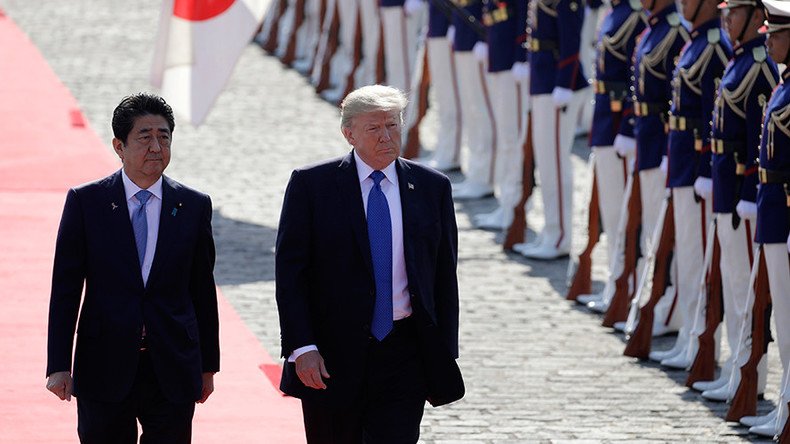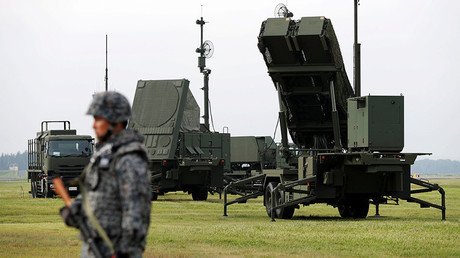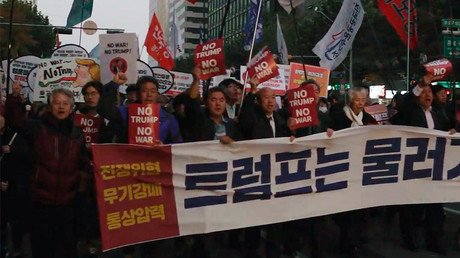Trump's Asian trip: ‘Washington seeks to contain China, while avoiding confrontation’

The real priority of US President Donald Trump’s Asian tour could be forming a coalition to contain China, Andrew Leung, an expert on China, told RT. He added that the US leader does not want to openly “confront” Beijing.
Trump arrived in Japan on Sunday as he started his 12-day Asian tour, the longest for an American president in over two decades. The US leader is also expected to visit Vietnam, China, the Philippines, and South Korea during this journey. In Vietnam, he is also scheduled to attend the Asia-Pacific Economic Cooperation (APEC) summit, where he could meet with Russian President Vladimir Putin.
Even though Trump seemingly focused his attention on North Korea and its nuclear program as he already made several statements concerning the matter, the real agenda behind his tour might not be necessarily centered solely on Pyongyang, Leung told RT. The real driving force behind the US leader’s endeavor might be “a lack of full scale trust between the two superpowers – the US and China.”
The Asia-Pacific region has emerged as the “main theater” of the policy aimed at protection of the US influence as well as of the interests of the American businesses.“High on the agenda is this rivalry or containment of China,” Leung said.
“You can see that he’s visiting Japan, which is America’s closest ally. Japan’s top priority also is containment of China. That is why he is visiting Japan first. Secondly, he is visiting South Korea, [so] hopefully he’s going to form a [US]-Japanese-South Korean kind of alliance against China.”
The US leader comes to Japan at a time when its bilateral relations with China are also marked by a lack of mutual trust – a fact that could push Tokyo right into the hands of Washington. Seoul has much warmer relations with Beijing, but at the same time it is almost fully dependent on the “US military umbrella” in the view of the threat from the North, which the South regards as an “existential” one. Such dualism could make Seoul another instrument in Washington’s game with Beijing.
Trump also plans to put pressure on Beijing to urge it to put more efforts in resolving the crisis around North Korean nuclear program, Leung said. As for North Korea itself, he believes that the US is unlikely to make it abandon its nuclear ambitions, even with the active help of China.
The nuclear program is regarded by Pyongyang as the only credible “insurance policy” that could help it counter external threats to the regime, the expert said, adding that it is precisely why the North’s leader Kim Yong-un is so actively seeking to acquire the intercontinental delivery capability for his nuclear weapons.
“After so many rounds of talks … the North Koreans don’t trust the US anymore, they don’t trust their words and they regard the acquisition of the ICBM [intercontinental ballistic missile] delivery and a nuclear powerful arsenal as the only insurance policy,” Leung told RT, adding that “not even China can change that.” Under the present circumstances, the only way to effectively resolve the North Korean crisis is to actually recognize Pyongyang’s nuclear status, the expert said.
He then drew parallels between the North Korean nuclear program and that of China in the 1960s. The Chinese program also prompted protests from Washington but eventually the US had to recognize the nuclear status of China and its program did not “seem to translate into [any] kind of threat,” he said.
Leung went on to suggest a two-phase solution of the Korean crisis, involving the “world coming to terms with the nuclear armed North Korea [possessing] delivery systems capable of reaching the US” in the first phase. The second phase aimed at resolving the issues between Pyongyang and Washington would envisage singing a formal non-aggression pact between North Korea and the US, coupled with de-escalation on both sides.














